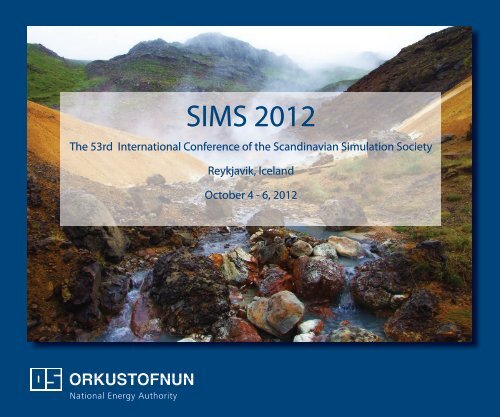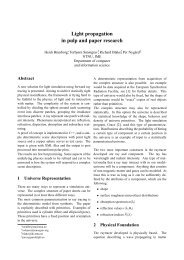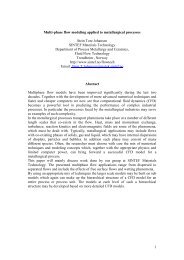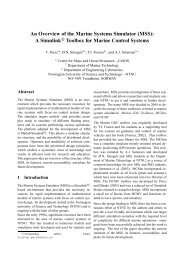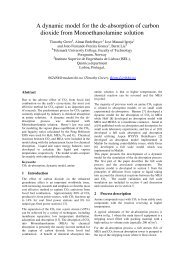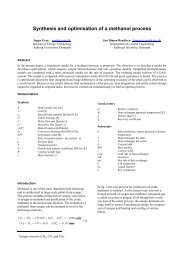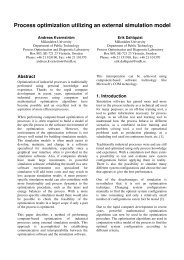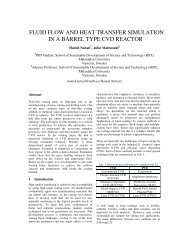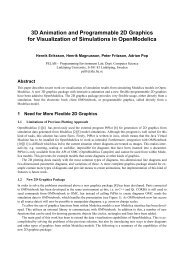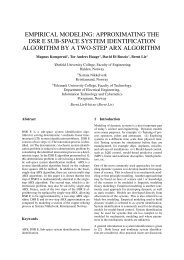detailed programme - SIMS - Scandinavian Simulation Society
detailed programme - SIMS - Scandinavian Simulation Society
detailed programme - SIMS - Scandinavian Simulation Society
You also want an ePaper? Increase the reach of your titles
YUMPU automatically turns print PDFs into web optimized ePapers that Google loves.
<strong>SIMS</strong> 2012<br />
The 53rd International Conference of the <strong>Scandinavian</strong> <strong>Simulation</strong> <strong>Society</strong><br />
Reykjavik, Iceland<br />
October 4 - 6, 2012
53rd <strong>Scandinavian</strong> <strong>Simulation</strong> and Modeling <strong>Society</strong> <br />
conference<br />
Orkustofnun, Orkugarði, Grensásvegi 9 <br />
October 4-‐6, 2012<br />
Thursday -‐ October 4th<br />
Opening session<br />
8:30 9:00 Morning refreshments<br />
9:00 9:05 Welcome note from chair<br />
9:05 9:25 Gudni A. Johannesson Energy in Iceland and Modeling<br />
9:25 9:45<br />
9:45 10:15 Break<br />
Robert Podgorney, Hai Huang, <br />
Chuan Lu and Derek Gaston<br />
A Globally-‐Implicit Computational Framework for Physics-‐<br />
Based <strong>Simulation</strong> of Coupled Thermal-‐Hydro-‐Mechanical <br />
Problems: Application to Geothermal Reservoirs<br />
Session 2 -‐ Simulator development and optimization<br />
10:15 10:35 Esko Juuso Optimisation of energy collection in a solar power plant<br />
10:35 10:55 Bernt Lie and Finn Haugen Scripting modelica models by Python<br />
10:55 11:15 Kourosh Mousavi Takami<br />
Partial discharge simulation and modeling in large scale <br />
generators using FEM method<br />
11:30 12:30 Lunch (with <strong>SIMS</strong> Board Meeting)<br />
Session 4 -‐ Case studies in oil, solar and hydro<br />
12:30 12:50<br />
Tuong-‐Van Nguyen and Brian Modelling and analysis of offshore energy systems on North <br />
Elmegaard<br />
Sea oil & gas platforms<br />
12:50 13:10 Jónas Elíasson Optimizing the design of hydropower stations<br />
13:10 13:30<br />
Arash M. Dizqah, Krishna Busawon Acausal Modelling and simulation of standalone solar power <br />
and Peter Fritzson<br />
systems as hybrid dae<br />
13:30 14:00 Break<br />
Session 4 -‐ Case studies in water use, CO2 capture, fuel reactors and other<br />
14:00 14:20<br />
Úlfar Linnet and Óli Grétar Blöndal <br />
Design of new hydroelectric power projects in Iceland<br />
Sveinsson<br />
14:20 14:40<br />
Gudni Axelsson, Thorsteinn Egilson Modelling of Temperature Conditions near the Bottom of <br />
and Sigrídur S. Gylfadóttir Well IDDP-‐1 in Krafla, N-‐Iceland<br />
14:40 15:00<br />
Jussi Immonen, Sulo Lahdelma and Condition monitoring of an epicyclic gearbox at a water <br />
Esko Juuso<br />
power station<br />
15:20 15:40 Riku-‐Pekka Nikula<br />
Input Variable Selection in Modelling of Desulphurization <br />
Efficiency<br />
15:40 16:00<br />
Björn Sveinbjörnsson and Sverrir <br />
Thorhallson<br />
Cost and effectiveness of geothermal drilling<br />
<strong>SIMS</strong> Annual General Assembly<br />
16:00 17:00 <strong>SIMS</strong> Annual general assembly<br />
19:00 Dinner
Friday -‐ October 5th<br />
Session 5 -‐ IEA-‐GIA work on Sustainable use of geothermal resources<br />
8:30 9:00 Morning refreshments<br />
9:00 9:20 Gudni Axelsson Modelling sustainable geothermal utilization<br />
9:20 9:40 S. Lopez, V. Hamm, O. Goyeneche<br />
9:40 10:00 Manuel Monterrosa<br />
10:00 10:30 Break<br />
Session 6 -‐ Simulator development and optimization<br />
10:30 10:50 Robert Braun and Petter Krus<br />
10:50 11:10<br />
Axel Ohrt Johansen and Brian <br />
Elmegaard<br />
11:10 11:30 Dietmar Winkler and Bernt Lie<br />
11:30 11:50<br />
12:00 13:00 Lunch<br />
Erik Dahlquist, Elena Tomas <br />
Aparicio, Hailong Li, Peter Fritzon <br />
and Per Östlund<br />
Optimal and sustainable use of the Dogger aquifer <br />
geothermal resource: long-‐term management and new <br />
technologies<br />
Sustainability analysis of the Berlin geothermal field, El <br />
Salvador<br />
Towards A Parallel Distributed Equation-‐Based <strong>Simulation</strong> <br />
Environment<br />
A homogeneous two-‐phase flow model of an evaporator <br />
with internal rifled tubes<br />
Hydro Power Systems: Scripting Modelica Models for <br />
Operational Studies in Education<br />
COMPARISON OPEN MODELICA -‐ DYMOLA FOR POWER <br />
PLANT SIMULATION<br />
Session 7 -‐ Modeling of geothermal systems<br />
13:00 13:20<br />
Gunnar Gunnarsson and Edda S.P. Boundary conditions and heat sources in geothermal <br />
Aradóttir<br />
reservoir modelling<br />
13:20 13:40<br />
Larus Thorvaldsson and Halldor Modeling Two Phase Flow and Phase Change in Liquid <br />
Palsson<br />
Dominated Hydrothermal Systems<br />
13:40 14:00 Thora Hlin Thorisdottir<br />
Estimation of slip ratio correlations for two phase flow in <br />
Icelandic Geothermal Wells<br />
14:00 14:20<br />
Development of a Coupled Geothermal Reservoir-‐Wellbore <br />
Halldora Gudmundsdottir, Magnus <br />
Simulator Using Measured Wellhead Parameters and <br />
Thor Jonsson and Halldor Palsson<br />
Inverse Analysis.<br />
14:20 14:50 Break<br />
Session 8 -‐ Modeling<br />
Ulrik Larsen and Tuong-‐Van <br />
14:50 15:10<br />
Nguyen<br />
15:10 15:30<br />
15:30 15:50<br />
Jani Tomperi, Esko Juuso and <br />
Kauko Leiviskä<br />
Sanoja Jayarathna, Achini <br />
Weerasooriya, Bernt Lie and <br />
Morten Melaaen<br />
Development of a multi-‐level approach to model and <br />
optimise the Kalina Split Cycle<br />
Automatic chromatogram analysis<br />
Dynamic operations of the Stripping Column of a CO2 <br />
capture plant<br />
15:50 16:10<br />
Úlfar Linnet and Óli Grétar Blöndal <br />
Long-‐term hydro and geothermal reservoir operation<br />
Sveinsson<br />
16:10 16:30 Closing remarks by chair
Opening Session<br />
Abstract:<br />
Paper 5:<br />
Title: A Globally-Implicit Computational Framework for Physics-Based<br />
<strong>Simulation</strong> of Coupled Thermal-Hydro-Mechanical Problems:<br />
Application to Geothermal Reservoirs<br />
Keyword: modeling, multiphysics, coupled processes, geothermal,<br />
geomechanics.<br />
Abstract: Numerical modeling has played an important role in understanding the<br />
behavior of geothermal systems since as early as the 1970s.While capabilities of<br />
geothermal reservoir simulators have grown since then, the prospect of<br />
simulating more challenging classes of geothermal problems–such as reservoir<br />
creation and operation of engineered geothermal systems (EGS), high enthalpy<br />
supercritical magmatic systems, etc–pose additional, and very significant,<br />
computational challenges that the current generation of continuum or dual<br />
continuum hydrothermal models are ill-equipped to describe. Interest in<br />
multiphysics simulation techniques is growing rapidly with a focus on more<br />
realistic and higher fidelity analysis of geothermal and engineering systems. This<br />
in- crease in activity is typically attributed to increasing computer power and<br />
more robust computational schemes [3, 4, 5], but in truth, advanced numerical<br />
methods are playing an equal role. The phrase “multiphysics simulation” is used<br />
to describe analyses which include disparate physical phenomena–such as<br />
coupled multiphase, multicomponent fluid flow, enthalpy transport, and<br />
geomechanics and their feedbacks–are examined in a simul- taneous manner.<br />
Examples of multiphysics problems in subsurface energy applications are<br />
numerous and include pressure and temperature driven permeability creation and<br />
evolution in geothermal reservoirs, temperature driven phase evolution of in-situ<br />
kerogen processing of oil shale reservoirs,kinetically controlled reactive transport<br />
in the flow of contaminants, etc. In addition to multiphysics coupling, most of<br />
these problems also have multiscale issues to resolve. Examining coupled physics<br />
for fluid flow, energy transport, and geomechanical deforma- tion is a relatively<br />
new area for the geothermal community; however, simulating coupled problems<br />
has<br />
been an important topic of study in the reactive transport community for<br />
decades. Yeh and Tripathi [9] and Steefel and MacQuarrie [7] cite three major<br />
ap- proaches that differ in the way coupling transport and reaction have been<br />
considered for reactive transport modeling: (1) GIA (fully-coupled) approach that<br />
solves all governing nonlinear equations simultaneously at each time step using<br />
various forms of Newton’s method, (2) sequential iteration approach (SIA) that<br />
subdivide the reactive transport problem into transport and reaction<br />
subproblems, solves them sequentially, and then iterates, and (3) sequential<br />
non-iteration approach (SNIA) that solves the transport and reaction problems<br />
sequentially without iteration, which is often referred as operator- splitting. The<br />
operator-splitting approach is perhaps the simplest to implement and requires the<br />
least computational resources in terms of the memory and CPU time; thus, it<br />
became the method of choice for subsurface reactive transport modeling during<br />
the past three decades. However, the drawback of the operator-splitting<br />
approach is the splitting error when the physics (either reactions-transport or<br />
flowmechanics) are tightly coupled; the solution becomes inaccurate and requires<br />
very small time steps [8]. For most potential EGS reservoirs fluid flow, heat<br />
transport, and rock deformation will be strongly nonlinearly coupled. The changes<br />
in flow and energy transport properties due to fracturing and/or dissolution add<br />
further complexity and nonlinearity to the problem. For such situations, the global<br />
implicit approach (GIA) solves all solution variables simultaneously during each<br />
time step by seeking the solution of a large system of nonlinear equations via<br />
some form of Newton’s method and is a more robust solution than the other two
approaches [1, 2, 6]. The work described in this paper highlights the<br />
development of a fully-coupled and fully- implicit modeling tool for predicting the<br />
dynamics of fluid flow, heat transport, and rock deformation using a GIA named<br />
FALCON (Fracturing And Liquid CONvection). The code is developed on a parallel<br />
Multiphysics Object Oriented <strong>Simulation</strong> Environment (MOOSE) computational<br />
framework developed at Idaho National Laboratory (INL) for providing finite<br />
element solutions of coupled system of nonlinear partial differential equa- tions.<br />
In this paper, a brief overview of the governing equations numerical approach are<br />
discussed, and an example simulation of strongly coupled geothermal reservoir<br />
behavior is presented.<br />
Author: Robert Podgorney, Hai Huang, Chuan Lu and Derek Gaston.<br />
Session 2 - Simulator development and optimization<br />
Paper 23:<br />
Title: Optimisation of energy collection in a solar power plant<br />
Keyword: Solar energy, intelligent control and optimization, nonlinear systems,<br />
linguistic equations, dynamic simulation<br />
Abstract: Solar power plants should collect any available thermal energy in a<br />
usable form at the desired temperature range, which improves the overall system<br />
efficiency and reduces the demands placed on auxiliary equipment. In addition to<br />
seasonal and daily cyclic variations, the intensity depends also on atmospheric<br />
conditions such as cloud cover, humidity, and air transparency. A fast start-up<br />
and efficient operation in varying cloudy conditions is important. Solar thermal<br />
power plants should provide thermal energy for use in an industrial process such<br />
as seawater desalination or electricity generation. Unnecessary shutdowns and<br />
start-ups of the collector field are both wasteful and time consuming. With fast<br />
and well damped controllers, the plant can be operated close to the design limits<br />
thereby improving the productivity of the plant.<br />
This study is based on tests done in Spain: the Acurex field supplies thermal<br />
energy in form of hot oil to an electricity generation system or a multi-effect<br />
desalination plant. The field consists of parabolic-trough collectors. Control is<br />
achieved by means of varying the flow pumped through the pipes in the field<br />
during the operation. Solar power plants can collect energy only when the<br />
irradiation is high enough. The nights and the heavy cloud periods need to come<br />
up with the storage. The demand may also vary during the daytime. The<br />
operation mode should be adapted to current operating conditions, weather<br />
forecasts and plans of the energy use. Different scenarios are compared with an<br />
intelligent dynamic simulator based on case specific linguistic equation models.<br />
Authors: Esko Juuso<br />
Paper 7<br />
Title: Scripting Modelica models by Python<br />
Keyword: Modelica, Python, scripting, control<br />
Abstract: Modelica is a modern language for describing large scale,<br />
multidisciplinary dynamic systems (Fritzson, 2011), and models can be built from<br />
model libraries or the user can develop her own models or libraries using a text<br />
editor and connect the submodels either using a text editor or a visual tool.<br />
Several commercial tools exist, such as Dymola<br />
(www.3ds.com/products/catia/portfolio/dymola),<br />
MapleSim
(www.maplesoft.com/products/maplesim) , Wolfram SystemModeler<br />
(www.wolfram.com/system-modeler) , etc. Free/research based tools also exist,<br />
e.g. OpenModelica (www.openmodelica.org) and JModelica (www.jmodelica.org).<br />
More tools are described at www.modelica.org.<br />
For most applications of models, further analysis and post processing is required,<br />
including e.g. model calibration, sensitivity studies, optimization of design and<br />
operation, model simplification, etc. Although Modelica is a rich language, the<br />
lack of tools for analysis has been a weakness of the language as compared e.g.<br />
to Matlab, etc. Two commercial products are thus based on integrating Modelica<br />
with Computer Algebra Systems (MapleSim, Wolfram SystemModeler), while for<br />
other tools the analysis part has been more cumbersome (although Dymola<br />
includes possibilities for model calibration, an early but simple way of controlling<br />
models from Matlab, etc.). A recent development has been the FMI standard<br />
(www.functional-mockup-interface.org), which promises to greatly simplify the<br />
possibility to script e.g. Modelica models from Matlab or Python<br />
(www.modelon.com: FMI Toolbox for Matlab; www.jmodelica.org/page/4924:<br />
PyFMI for Python). Several Modelica tools now offer the opportunity to export<br />
models as FMUs (Functional Mock-up Units), whereupon PyFMI can be used to<br />
import the FMU into Python. Or the FMU can be directly generated from PyFMI.<br />
PyFMI is integrated into the JModelica tool. More extensive integration with<br />
Python is under way for other (free) tools, too.<br />
Python 2.7 with packages Matplotlib, NumPy, and SciPy offer many tools for<br />
analysis of models; a simple installation is EPD Free (www.enthought.com), but<br />
many other installations exist. Comparing Python to Matlab for use in control<br />
studies reveals clear advantages and clear disadvantages for Python. Python is a<br />
free tool, and a rich programming language. However, there is (currently) no<br />
control toolbox for Python, the various packages and sub packages are not so<br />
well documented, and the quality of some tools are far from perfect. Yet, the<br />
combination of Python and Modelica/PyFMI offers ample opportunities for analysis<br />
of models and control studies.<br />
Still, the FMI does not offer perfect access to the inner model description of<br />
Modelica models. Thus, some on-going work considers extending the Modelica<br />
language with support for e.g. optimal control (www.jmodelica.org) as a way to<br />
better take advantage of the model information and develop more efficient<br />
solvers than what can achieved externally from e.g. Python. For the control field,<br />
this is a very interesting development.<br />
This paper gives an overview of basic possibilities for doing model based control<br />
studies by scripting Modelica models from Python. As a case study, the ideas will<br />
be applied in the field of renewable energy from bio waste, Haugen et al. (2012).<br />
References<br />
Fritzson, P. (2011). Introduction to Modeling and <strong>Simulation</strong> of Technical and<br />
Physical Systems with Modelica®. IEEE Press and Wiley, Hoboken, New Jersey.<br />
Haugen, F., Bakke, R., and Lie, B. “Mathematical Modelling for Planning Optimal<br />
Operation of a Biogas Reactor for Dairy Manure”. Presented at the IWA World<br />
Congress on Water, Climate and Energy (IWA-WCE), Dublin, 14 – 18. May<br />
2012. Authors: Bernt Lie, Finn Haugen.<br />
Paper 1<br />
Title: Partial discharge simulation and modeling in large scale generators using<br />
FEM method
Keyword: Partial, discharge, generator<br />
Abstract: All large scale electrical Turbo, gas and hydro driven generators will<br />
experience partial discharge (PD), even from new. Accordingly, over 30% of<br />
unwanted outages and subsequent production loss can be oriented from<br />
insulation failure. PD created when the electrical field to be higher than the<br />
breakdown field of insulating. Partial discharges attributed to different factors:<br />
stresses of the insulation, thermal (temperature), electrical (electric field),<br />
ambient (environment), mechanical (vibrations). Usually defects take place in<br />
specific locations; there is no overall average ageing. Corrosion, aging and finally<br />
electrical break down are results of PD. With regard to increase of discharge<br />
levels over time, eventually failure occurs.<br />
Consequently, to find a solution for monitoring of partial discharge is vital. Thus,<br />
the method of partial discharge simulation (PDS) can be a preventive diagnostic<br />
approach that uses PD simulation to evaluate the integrity of large scale medium<br />
voltage<br />
generators.<br />
Current, voltage, load angle, active and reactive powers in terminal of generator<br />
is measured, electric and magnetic fields calculated with using of classic formulas.<br />
Those are used to simulate of PD. The accumulated electric charges in epoxy<br />
resin, mica tape bandages, and insulations will obtain by calculation and<br />
simulation. The evolution of the electrical treeing is evaluated, as well.<br />
Presented paper describes how simulation used to monitor of PD. Finally,<br />
simulated results are verified with obtained experimental data from instruments<br />
that detect airborne ultrasound and harmonic analyzed PD with capacitance<br />
divider, those apparatuses are used to detect and evaluate partial discharge in<br />
electrical machines.<br />
Authors: Kourosh Mousavi Takami<br />
Session 3 – Case studies in oil, solar and hydro<br />
Paper 6<br />
Title: Modelling and analysis of offshore energy systems on North Sea oil & gas<br />
platforms<br />
Keyword: modeling, energy systems, exergy analysis, oil and gas platforms<br />
Abstract: Offshore processes are associated with significant energy consumption<br />
and large CO2-emissions. Conventional North Sea oil and gas facilities include the<br />
following operations: crude oil separation, gas compression and purification,<br />
wastewater treatment, gas lifting, seawater injection, oil and gas export, and<br />
power generation. In this paper, a generic model of a North Sea oil and gas<br />
platform is described and the most thermodynamically inefficient processes are<br />
identified by performing an exergy analysis. Models and simulations are built and<br />
run with the tools Aspen Plus®, DNA and Aspen HYSYS®. Results reveal that the<br />
total exergy destruction of the system is particularly sensitive to the gas-to-oil<br />
ratio and amounts to 55-65 MW, while the total exergy losses amount to 15-20<br />
MW. The gas compression train and the production manifold module are the most<br />
exergy-destructive operations of the oil and gas processing system, consuming 4-<br />
6 MW and 3-7 MW respectively, while the power generation system alone is<br />
responsible for 54-63 MW.<br />
Authors: Tuong-Van Nguyen, Brian Elmegaard.<br />
Paper 31<br />
Title: Optimizing the design of hydropower stations
Keyword: hydropower, optimization, genetic algorithm<br />
Abstract: State of the art: Local optimization is common knowledge but leads to<br />
difficult calculations and time consuming search for an optimum. Global<br />
optimization is difficult in spreadsheets or matlab software but becomes easy in a<br />
software using Genetic Algorithms. An Objective Function is built by finding the<br />
net present value of the future income from energy sales and subtracting the<br />
financial and running costs. The basic equations are studied; different objectives,<br />
resource utilization policies and environmental considerations are discussed with<br />
respect to their influence on the result. In the final phase a Genetic Algorithm<br />
routine search out an optimum and this is demonstrated on a case study<br />
example.Authors: Jonas Eliasson, Gudmundur Ludvigsson<br />
Organization: Univ Iceland, Iceconsult<br />
Paper 4<br />
Title: ACAUSAL MODELLING AND SIMULATION OF STANDALONE SOLAR POWER<br />
SYSTEMS AS HYBRID DAE<br />
Keyword: Hybrid DAE, Photovoltaic, Battery, C-DC converter, Modelica, Acausal<br />
modeling, Standalone solar power system<br />
Abstract: Due to the presence of algebraic constraints and its different modes of<br />
operation, a standalone solar power system consisting of photovoltaic arrays,<br />
battery bank, electrical load, and a converter is becoming more complex and can<br />
no longer be modelled using conventional causal techniques based on ordinary<br />
differential equations. A more appropriate way to model these complex systems<br />
is to use hybrid differential algebraic equations (hybrid DAE). In effect, in this<br />
paper, we propose a nonlinear hybrid DAE-based model of a standalone solar<br />
power system. The model is developed using the Modelica language that allows<br />
object-oriented and acausal modelling of multi-mode systems. The developed<br />
model is solved employing general purpose hybrid DAE solvers to simulate the<br />
system. The results of the simulation indicate good accuracy for the variables of<br />
components as well as the proper match with the information available from<br />
manufacturer datasheets. It is shown that the simulation provides sufficiently<br />
accurate prediction of the transient behaviour of the system including mode<br />
transitions which is vital for any model-based controller.<br />
Authors: Arash M. Dizqah, Krishna Busawon, Alireza Maheri, Peter Fritzon.<br />
Organization: Northumbria University, Linköping University.<br />
Paper 11<br />
Title: CFD Modelling of Gas Explosions<br />
Keyword: confined explosions, CFD, multiple obstacles, RANS model, simulation,<br />
deflagration<br />
Abstract: Nowadays, safety is an integral part of industrial projects. Neglecting<br />
safety causes financial and personal tolls. Many severe accidents which cause<br />
large losses are happened by explosion of fuels. Piper Alpha, Macondo accident in<br />
Mexican gulf and Buncefield explosion are some examples related to neglecting<br />
safety. Severity of explosions in oil and gas industries is so high because of<br />
processing and storing a large amount of fuels and high level of congestion. In<br />
order to investigate the factors that affect explosion behavior, many researches<br />
have been done. Different methods are used to examine explosion behavior.<br />
Experimental and simulation methods are two ways of investigation.<br />
Experimental method is one of testing methods in oil and gas industries. Many<br />
experiments had been done until 1992.However scales of those experiments were<br />
much smaller than similar cases in real world. So extrapolation’s results may not
e reliable. In 1992, Shell research center conducted SOLVEX (Shell Offshore<br />
Large Vented Explosions) tests to investigate explosion behavior with different<br />
levels of congestion. In the experiments, gas explosion measurements were<br />
performed in a vented box with internal obstructions. Measurements were<br />
performed with both methane and propane as combustible gas. Although doing<br />
experimental tests are too costly and sometimes it is impossible to be done.<br />
Another alternative is to simulate the explosion by using computational fluid<br />
dynamics. Progress in technology causes production of powerful computers with a<br />
higher computing speed and also powerful softwares to accomplish simulation in<br />
Computational Fluid Dynamics such as OpenFOAM. In this Study, simulation of<br />
explosion is carried out by using the open source code OpenFOAM because<br />
commercial computer software has limited insight into the physical modelling.<br />
The simulation is based on SOLVEX experiments. Geometries with different level<br />
of congestion were generated and control volumes were produced for further<br />
calculations. Indeed about 30000 control volumes were generated. XiFOAM solver<br />
which was used finite volume method was normally adopted to simulate explosion<br />
inside the enclosure. Mass, momentum, energy and transport equations were<br />
solved in the control volumes. KEpsilone model was used as RANS (Reynolds<br />
Averaged Navier Stokes) model. At the end, over pressures and flame<br />
propagation speed were measured and compared with the experimental results.<br />
Explosion behavior in simulations had a good agreement with experimental<br />
method. The simulation results show that higher levels of congestion generated<br />
stronger overpressures and it also increased the flame propagation speed.<br />
Authors: Behrouz Hemmatian, Tron Solberg, Knut Vågsæther.<br />
Session 4 – Case studies in water use, CO2 capture, fuel reactors and<br />
other<br />
Paper 25<br />
Title: Design of new hydroelectric power projects in Iceland<br />
Keyword: Hydroelectric, Design, <strong>Simulation</strong>, Dynamic programming, Reservoir,<br />
Linear programming<br />
Abstract: This presentation gives a broad description of the use of simulation in<br />
the design process of latest hydroelectric power projects being developed by<br />
Landsvirkjun.<br />
The design of new hydroelectric projects at Landsvirkjun is aided by simulation of<br />
their operation. New projects can, however, change the optimal operation of<br />
existing reservoirs and hydroelectric stations. For that reason simulations always<br />
include the total existing power system plus the project beeing studied.<br />
Landsvirkjun uses it proprietary simulation software based on a well known two<br />
step process of water value calculation and simulation of operation as described<br />
in Lindqvist 1962. Further developement includes an iterative process to allow the<br />
simulation of multiple watersheds with different flow characteristics and<br />
identification of transmission bottlenecks.<br />
Authors: Úlfar Linnet, Óli Grétar Blöndal Sveinsson.<br />
Paper 30<br />
Title: Modelling of Temperature Conditions near the Bottom of Well IDDP-1 in<br />
Krafla, N-Iceland<br />
Keyword: geothermal system, magma intrusion, temperature conditions,<br />
modelling
Abstract: The transient temperature conditions near the bottom of well IDDP-1<br />
in Krafla, which was drilled into a magma intrusion, have been simulated by some<br />
simple models addressing: (i) evolution of temperature conditions at the magma<br />
intrusion, (ii) cooling of a permeable layer above the magma due to drilling<br />
circulation losses, (iii) reheating of the permeable layer after drilling and (iv)<br />
temperature evolution during discharge testing in 2010. The modelling is quite<br />
speculative because of limited data constraints, but results indicate that the<br />
temperature conditions and evolution can be explained by the models used. The<br />
possibility that the magma was emplaced during the Krafla volcanic episode 25 –<br />
35 years ago can neither be confirmed nor refuted, but if the intrusion is so old a<br />
thickness of at least 50 – 100 m is required. The effective thick¬ness of the<br />
permeable layer and its equilibrium temperature, are estimated to be about 45 m<br />
and 390 – 400°C, respectively. No direct contact with the magma is needed to<br />
explain the superheated (up to 380°C) steam discharged by well IDDP-1. The<br />
situation near the bottom of the well clearly warrants further study, both through<br />
more complex modelling and with further data-constraints.<br />
Authors: Guðni Axelsson, Thorsteinn Egilson, Sigríður S. Gylfadóttir.<br />
Paper 24<br />
Title: Condition monitoring of an epicyclic gearbox at a water power station<br />
Keyword: condition monitoring, diagnostics, higher order derivatives, epicyclic<br />
gearbox<br />
Abstract: Epicyclic gearing or planetary gearing is a gear system, which consists<br />
of one or more outer gears, or planet gears, revolving about a central, or sun<br />
gear. Typically, the planet gears are mounted on a movable arm or carrier which<br />
itself may rotate relative to the sun gear. Epicyclic gearboxes are challenging to<br />
monitor due to complex structure with many rolling elements. Complex structure<br />
and versatile components also mean a long stoppage if a failure occurs.<br />
Therefore, an early detection of incipient faults is important.<br />
In this paper, vibration analysis is used for condition monitoring of an epicyclic<br />
gearbox at a water power station. There is a distinct difference between vibration<br />
quantities: vibration velocity responds very well to the vibrations with frequencies<br />
less than 1000 Hz; an even better response is gained by acceleration and its<br />
higher derivatives, which also include more information on higher frequencies.<br />
Because of a quite high rotational speed of the output, the vibration velocity is<br />
not good enough for condition monitoring of the gear in question. Acceleration<br />
and its higher order derivatives should be used to get better responsiveness for<br />
changes in the condition of the gearbox.<br />
Modelling is needed to calculate the vibration components in the frequency range<br />
to identify the possible faulty components. There was also one vibration<br />
component in the gear, which source was not definitely discovered.<br />
Authors: Jussi Immonen, Sulo Lahdelma, Esko Juuso.<br />
Paper 18<br />
Title: Input Variable Selection in Modelling of Desulphurization Efficiency<br />
Keyword: desulphurization plant, input variable selection, modelling<br />
Abstract: Several methods are applied in order to find the input variables with<br />
predictive power to the modelling of SO2 removal efficiency in a desulphurization<br />
plant. In model development, the preliminary assumption is that one or several<br />
candidate variables are capable of describing some of the output behaviour. In<br />
non-linear and complex industrial processes, the nature of the relationships<br />
between the variables may be vague and a functional first principles based model<br />
may be impossible to define. Therefore, it is justified to use data-driven statistical<br />
modelling approaches such as artificial neural networks (ANNs). However, such<br />
models may become corrupted due to the inclusion of uninformative, weakly<br />
informative or redundant variables. In this study, the emphasis is on the selection
of the informative variables, and therefore, the determination of the best<br />
performing model for the SO2 removal efficiency is ignored.<br />
The tentative selection of the variables is done based on the knowledge of the<br />
actual process. In addition, new variables are formed from the existing ones and<br />
added to the set of candidates. Linear relationships are evaluated with the linear<br />
correlation coefficient. Self-organizing maps (SOM) are used to visualize the high<br />
dimensional input space in a low dimensional map space. Principal component<br />
analysis (PCA) and partial least squares (PLS) regression are used as the<br />
methods of reducing the input dimensionality and forming new combinations of<br />
the input variables. Mutual information (MI) based algorithms are used to<br />
measure both linear and nonlinear relationships between the variables. The<br />
results show that the different methods give guidance to the input variable<br />
selection challenge. The results benefit the future steps of the desulphurization<br />
plant modelling.<br />
Authors: Riku-Pekka Nikula<br />
Paper 34<br />
Title: Cost and effectiveness of geothermal drilling.<br />
Keyword: Effectiveness in drilling<br />
Risk in drilling<br />
Productivity and injectivity<br />
Abstract: For geothermal power projects about 40-50% of the total investment<br />
cost lies in drilling of the pro-duction and reinjection wells and the steam supply<br />
system to the plant. Current geothermal project costs for conventional flashsteam<br />
plants are about 4,000 USD per kilowatt (kW ) of power. Roughly half of<br />
the well cost comes from materials and infrastructure and the other half is from<br />
the rental of rigs and services (day rates). Drilling of each hole to 2,000-2,500 m<br />
may take anywhere from 32 to 60 days. The cost of wells does thus critically<br />
depend on the effectiveness of drilling, that is to say the numb¬er of working<br />
days. The paper describes an analysis of the drilling performance of 77 hightemp-erature<br />
geothermal production and reinjection wells in the Hengill<br />
geothermal area in Iceland drilled from 2001 to 2011, and assesses the statistical<br />
level of risk. The study compares workdays in drill¬ing holes of two different<br />
casing <strong>programme</strong>s, and two trajectories of vertical or directional drill¬ing. The<br />
production casing was either of a regular diameter of 244.5 mm (9⅝") or a large<br />
dia¬met¬er of 339.7 mm (13⅜"). The workdays were normal¬ized to a<br />
refer¬ence well of four sections, Section 0 of initial drilling to 90 m, Section 1 to<br />
300 m, Section 2 to 800 m, and Section 3 to 2,235 m depth (Figure 3). The<br />
workdays used to drill each of the sections of the hole were broken down and<br />
analysed for seven different act-ivities. The average and standard deviation for<br />
each of the four well sections was calculated and the findings used for the model<br />
calculations. For large diameter holes an average of 45 days was required, but 47<br />
days for holes of the reg¬ular <strong>programme</strong>. No difference was found for vertical or<br />
directional<br />
trajectories.<br />
The Monte Carlo method was applied to obtain a statistical estimate of the<br />
number of workdays and the cost of a reference hole to 2,235 m with large<br />
casings and directionally drilled. The cost estimate is based on assumed prices for<br />
services and material, but not on the actual cost which was not made available<br />
for the study for comm¬ercial reasons. The actual drilling contract for Hellisheiði<br />
was based on meter rates (not day rates) and sharing of the risk when problems<br />
are encountered. The cost figures presented in this study reflect what the cost<br />
may be, but not the contract. The estimated cost was found to be $4,318,000<br />
with a standard deviation σ of $451,000. The cost lies with 95% con¬fidence<br />
between $3,517,000 and $5,262,000. About 31% of the holes encountered<br />
drilling problems which led to higher drilling costs. The additional cost due to<br />
drilling problems was estimated on the bas¬is of workdays that were requir¬ed
to solve the problem beyond the average number of workdays re¬quired in the<br />
respect¬ive section. In most cases the difficulties were due to a loss of circulation<br />
or coll¬apsing geological formations where the drill string got stuck. The<br />
add¬itional cost due to these problems was though low in most cases. It<br />
exceed¬ed 1 σ in 23% of the 77 drilled holes, 2 σ in 13% and 3 σ in only 8%.<br />
The majority of holes were thus drilled according to the original schedule,<br />
dem¬on¬¬strating that the perceived high risk of drilling such holes is less than<br />
commonly<br />
thought.<br />
The Injectivity Index ((kg/s)/bar) is determined at the end of drilling by logging<br />
the pressure response to different rates of pumping water onto the well, each<br />
step lasting a few hours. It serves as the first indicator of the well productivity.<br />
These results are compared to the final well output obtained later by flow testing.<br />
Such estimates of future production are valuable for deciding whether to drill<br />
deep¬er, drill a sidetrack or to apply well stimulation before moving the drilling<br />
rig off the well. The aver¬age generating capacity amounted to ~5.7 MW of<br />
electricity per well, but surprisingly there was not a significant difference in the<br />
mass flow output that could be related to the trajectory nor the well diameter.<br />
Authors: Björn Sveinbjörnsson and Sverrir Thorhallson<br />
Organization:<br />
Friday – October 5 th .<br />
Session 5 – IEA-GIA work on Sustainable use of geothermal resources<br />
Paper 29<br />
Title: Modelling sustainable geothermal utilization<br />
Keyword: geothermal system, sustainable utilization, modelling<br />
Abstract: Sustainable development involves meeting the needs of the present<br />
without compro¬mising the ability of future generations to meet their needs. The<br />
Earth’s enormous geothermal resources have the potential to contribute<br />
significantly to sustainable energy use worldwide and to help mitigate climate<br />
change. Experience from the use of geothermal systems worldwide, lasting<br />
several decades, demon¬strates that by maintaining production below a certain<br />
limit the systems reach a balance between net energy discharge and recharge<br />
that may be maintained for a long time. Therefore, a sustainability time-scale of<br />
100 to 300 years has been proposed. Modelling studies furthermore indicate that<br />
the effect of heavy utilization is often reversible on a time-scale comparable to<br />
the period of utilization. The long production histories that are available for geothermal<br />
systems worldwide provide the most valuable data available for studying<br />
sustainable management of geothermal resources, and reservoir modelling is the<br />
most powerful tool available for this purpose. Long utilization experiences from<br />
e.g. Iceland, New Zealand, El Salvador and China are reviewed and sustainability<br />
modelling studies for a few geothermal systems in these countries presented.<br />
Organization: Iceland GeoSurvey (ÍSOR)<br />
Paper 32<br />
Title: Optimal and sustainable use of the Dogger aquifer geothermal resource:<br />
long-term management and new technologies<br />
Keyword: Geothermal energy, Optimal use, Sustainable use<br />
Abstract: Geothermal energy has been supplying heat to district networks in the<br />
Paris Basin for more than 40 years. In this densely urbanized area, the main<br />
target of all exploration and exploitation projects has been the Dogger aquifer<br />
(1500-2000 m deep). Initial difficulties, due to corrosion and scaling related<br />
problems, have been overcome in the mid-1980s and, since then, operations<br />
have been providing heat daily to more than 150,000 dwellings. As most of the<br />
operating facilities use the “doublet” technology which consists of a loop with one
production well and one injection well. Injection of the cooled brines leads to the<br />
progressive exhaustion of the resource at the local doublet scale. Consequently,<br />
most of the research effort has been focused on quantifying the temporal<br />
evolution of the cooling, and to forecast the lifetimes of doublets and the<br />
occurrence of the “thermal breakthrough”.<br />
The 40 years of experience in geothermal exploitation of the Paris basin<br />
constitutes a firm basis upon which to devise a sustainable regional management<br />
approach for the geothermal resource. Yet, with the need for carbon free energy<br />
sources there has been a revival of geothermal energy development in France:<br />
many projects are presently being considered and new operations have already<br />
been carried out. In this context, it appears that the geothermal resource has to<br />
be managed and modeled as a whole. For this purpose, BRGM maintains an upto-date<br />
hydraulic and thermal model of the aquifer which can help policy makers<br />
to improve regulatory framework and which can support stake holders to carry<br />
out new operations. Moreover, because of potential conflicts of use which are<br />
emerging in densely exploited areas, a fine understanding of reservoir behavior is<br />
needed and new technological solutions must be developed: exploitation of<br />
underlying or overlying aquifers, seasonal heat storage...Authors: Simon Hamm<br />
Virginie, Goyeneche Olivier.<br />
Paper 33<br />
Title: SUSTAINABILITY ANALISYS OF THE BERLIN GEOTHERMAL FIELD, EL<br />
SALVADOR<br />
Keyword: Sustainability, Geothermal, Sustainable development<br />
Abstract: Over the past 20 years, the Berlin geothermal field has been in<br />
commercial operation through step wise development, at the moment the<br />
installed capacity is 109.2 MW. The total mass extracted ranges 860 kg/s which<br />
are delivered by 14 producer wells with average discharge enthalpy of 1300 kJ/kg<br />
and average steam flow rate of 20 kg/s. At the field, there are hot brine injection<br />
(180 and 140 °C) which is performed using 19 injection wells and cold injection<br />
(ambient temperature) with the operation of one well. A high pressure pumping<br />
station is also used manly when the gravity injection is going down. During the<br />
long term exploitation 18 bar of pressure drawdown was observed into the field<br />
and perhaps the main process observed in producer wells is boiling and there are<br />
no evidence of cooling due to injection.<br />
Since long term exploitation began sustainable development was a very<br />
important commitment for LaGeo, during the first stages of exploitation the field<br />
management, monitoring technics and numerical modeling were soon<br />
implemented. LaGeo as part of its corporative sustainable policy is focused to<br />
define the sustainable energy level and performance indicators; all of them are<br />
also part of concession contract granted by SIGET (electricity energy regulator<br />
entity) in year 2000.<br />
Preliminary results indicate the sustainable energy level of the Berlin resource is<br />
higher than the actual one, and there are defined at least 5 performance<br />
indicators which are: energy efficiency utilization, resource life, recovery time,<br />
subsidence, power plant performance. Authors: Manuel Monterrosa<br />
Organization: LaGeo<br />
Session 6 – Simulator development and optimization<br />
Paper 8<br />
Title: Towards A Parallel Distributed Equation-Based <strong>Simulation</strong> Environment<br />
Keyword: model generation, equation-based modeling, distributed solvers,<br />
symbolic expressions, numerical solvers, Hopsan, Modelica<br />
Abstract: Distributed solvers provide several benefits, such as linear scalability<br />
and good numerical robustness. By separating components with transmission line
elements, simulations can be ran in parallel on multi-core processors. At the<br />
same time, equation-based modelling offers an intuitive way of writing models.<br />
This paper presents an algorithm for generating distributed models from Modelica<br />
code using bilinear transform. This also enables hard limitations on variables and<br />
their derivatives. The generated Jacobian is linearised and solved using LUdecomposition.<br />
The algorithm is implemented in the Hopsan simulation tool.<br />
Equations are transformed and differentiated by using the SymPy package for<br />
symbolic mathematics. An example model is created and verified against a<br />
reference model. <strong>Simulation</strong> results are similar, but the equation-based model is<br />
four to five times slower. Further optimisation of the algorithm is thus required.<br />
The long-term aim is to develop a distributed simulation environment with<br />
support for equation-based modelling.<br />
Authors: Robert Braun, Petter Krus.<br />
Organization: Linköping University<br />
Paper 2<br />
Title: A homogeneous two-phase flow model of an evaporator with internal rifled<br />
tubes<br />
Keyword: Two phase flow, Evaporator, Internal rifled boiler tubes, Central WENO<br />
solver, Hyperbolic balance laws<br />
Abstract: In this article is developed numerical model for solving a transient one<br />
dimensional compressible homogeneous two phase model, on the basis of a two<br />
layer model for predominantly one-dimensional flows in a vertical pipe element<br />
with internal rifles. The two layer model uses a non-equilibrium approach and<br />
consist of two continuity equations, two momentum equations and two energy<br />
equations. The homogeneous model is based on the assumption of both<br />
hydraulic- and thermal equilibrium and the consequences and aspects will be<br />
discussed in that contest. The homogeneous flow model consists of three<br />
hyperbolic fluid conservation equations; continuity, momentum and energy and<br />
the pipe wall is modelled as a one dimensional heat balance equation. The models<br />
can be reformulated in the four un-dependant DOF's p(pressure), h(enthalpy)<br />
u(velocity) and T_w(wall temperature). Constitutive relations for the<br />
thermodynamic properties are limited to water/steam and is given by the IAPWS<br />
97 standard and wall friction and heat transfer coefficients are formulated by<br />
Churchill's friction model and by Jirous respectively.<br />
The numerical method for solving the homogeneous fluid equations is presented.<br />
The numerical method is based on a fifth order Central WENO scheme, with<br />
simplified weights functions.<br />
God convergence rate is established and the model is able to describe the entire<br />
evaporation process from sub cooled water to super heated steam at the outlet.<br />
Authors: Axel Ohrt Johansen, Brian Elmegaard.<br />
Organization: DONG Energy – Thermal Power, Technical University of Denmark<br />
– Thermal Energy Systems.<br />
Paper 21<br />
Title: Hydro Power Systems: Scripting Modelica Models for Operational Studies in<br />
Education<br />
Keyword: hydro-power-systems, modeling, simulation, education, optimization,<br />
open-source<br />
Abstract: The Telemark University College is running a master degree program<br />
called ``System and Control Engineering''.<br />
Most students of that program have a background in either electrical, mechanical,<br />
control engineering or a combination of those.<br />
Since Norway covers about 99\% of its electrical energy demand using hydroelectric<br />
power plants it is natural to also educate master students in the subject<br />
of hydro power systems.
About three years ago the Telemark University Colleges started a cooperation<br />
with the Norwegian power company ``Skagerak Energi'' in order to offer real-life<br />
projects for students to work on an establish a new teaching course for second<br />
year master students called ``Modelling and <strong>Simulation</strong> of Hydro Power<br />
Systems''.<br />
That course teaches the students the basic principles of hydro-electric power<br />
generation starting the prediction of precipitation ``down'' to the distribution of<br />
electrical power in the grid with other loads and consumers connected to it.<br />
Authors: Dietmar Winkler, Bernt Lie<br />
Organization: Telemark University College.<br />
Paper 35<br />
Title: COMPARISON OPEN MODELICA – DYMOLA FOR POWER PLANT SIMULATION<br />
Keyword: modelica, comparison, power plant<br />
Abstract: In this paper a comparison is made between OpenModelica and Dymola<br />
for a simulation model of a power boiler. The similarities and differences are<br />
presented. Dymola has the advantage of having a more elaborate user interface<br />
and solver, but the OpenModelica user interface and solver has improved very<br />
much during last few years. The advantage of OpenModelica is that anyone can<br />
use the models without having to pay high license fees, something that is of<br />
significant interest when installations are made in industries. In many ways a<br />
combination of the two is advisable, where Dymola can be used for application<br />
developments and later OpenModelica can be used in the actual installations. It<br />
has been seen in this application for a CFB boiler that it is easy to use the same<br />
model in both environments without any modifications. Still, the solver for Open<br />
Modelica is not as powerful as for Dymola, which may be a problem for on-line<br />
applications for larger models, while no problem for small models.<br />
Authors: Erik Dahlquist, Elena Tomas Aparicio, Hailong Li, Peter Fritzon<br />
and Per Östlund.<br />
Session 7 – Modeling of geothermal systems<br />
Paper 28<br />
Title: Boundary conditions and heat sources in geothermal reservoir modeling<br />
Keyword: Geothermal reservoir engineering, Reservoir modeling, Boundary<br />
conditions, Volcanism, Ground water<br />
Abstract: The energy sources of geothermal systems in volcanic areas are<br />
cooling and solidifying intrusions in the crust. The nature of the heat transfer<br />
from the hot bodies to the groundwater is not known in details. It is not known at<br />
what depth this interaction takes place. Neither is the depth range of the water<br />
circulations.<br />
When constructing a model of a geothermal field under production this issue is<br />
normally avoided. The heat sources are believed to be below the depth range of<br />
the model and are accounted for by choosing appropriate boundary condition in<br />
the model‘s bottom layer. Another standard practice in geothermal modeling is to<br />
assume that the geothermal system is in steady state, so called natural state,<br />
before production is simulated.<br />
This approach to model geothermal systems in volcanic areas has worked<br />
reasonably well for industrial purposes. However, a model that does not include<br />
the entire water circulation is not complete. Recently examples of wells drilled<br />
into very hot formations show that the industry cannot overlook this imperfection
in geothermal modeling. These wells along with other observations, indicate that<br />
the roots of the geothermal systems in the volcanic active zone in Iceland are at<br />
shallower depths that previously believed. Thus, the structure of existing<br />
numerical models have to be reconsidered and heat sources have to be included<br />
into the models.<br />
Including the heat sources into the models does also challenge the practice of<br />
assuming that the geothermal system is in a steady state or natural state, since<br />
intrusions in the roots of volcanoes are not steady phenomena. Periods of high<br />
intrusion activity are known in volcanic systems in Iceland. In an improved<br />
modeling scheme the heat sources should not only be included in the model along<br />
with the entire water circulation the should also be time dependent.<br />
Authors: Gunnar Gunnarsson, Edda S.P. Aradóttir<br />
Organization: Orkuveita Reykjavíkur<br />
Paper 19<br />
Title: Modeling Two Phase Flow and Phase Change in Liquid Dominated<br />
Hydrothermal Systems<br />
Keyword: reservoir modeling, two-phase flow, phase change, porous medium,<br />
scientific computing<br />
Abstract: A new modeling approach of two phase fluid flow in geothermal<br />
reservoirs is presented in the paper. The flow is assumed to be liquid dominated,<br />
but vapor will travel alongside the liquid at the same speed if present, which is<br />
common for hydrothermal systems. The model also accounts for phase changes,<br />
but they give rise to numerical instabilities due to the discontinuities in physical<br />
properties. An analysis is presented here on how to treat those instabilities in<br />
order to ensure a stable solution. The entire problem is then formulated and<br />
solved by using a highly customizable set of C++ libraries and tools, collectively<br />
named OpenFOAM, along with an implementation of the IAPWS-IF97 standard for<br />
the properties of steam and water.<br />
Preliminary results from a more general modeling work on hydrothermal systems<br />
are presented in simple case studies, showing the basic abilites of the<br />
programming platform to solve large three dimensional problems for flow in<br />
porous media. It is concluded that the modeling framework is both flexible and<br />
efficient, and an added benefit is that it is under constant improvement by a large<br />
group of developers and incorporates cutting edge technologies in numerical<br />
analysis for mathematical modeling.<br />
Authors: Larus Thorvaldsson, Halldor Palsson<br />
Organization: University of Iceland<br />
Paper 16<br />
Title: Estimation of slip ratio correlations for two phase flow in Icelandic<br />
Geothermal Wells<br />
Keyword: Two phase flow, Slip ratio, Pressure drop, Geothermal well
Abstract: Modeling of two phase flow is complex due to co-existence of<br />
turbulence effects and moving boundaries between the phases and the velocity<br />
difference between the two phases (gas and liquid). There are methods to<br />
evaluate the flow regimes but they depend on transport properties of the two<br />
phases, pipe roughness, mass, volume fraction in the pipe, and velocity ratio<br />
between the two phases. The velocity ratio is called the slip ratio and there is no<br />
simple way to evaluate it (Zhao, 2005).<br />
The idea of this project is to make a model for pressure drop in two phase flow in<br />
a geothermal well, compare the results with measured data from Icelandic<br />
Geothermal wells and fit the slip ratio to the data in effort to find out if there is a<br />
slip ratio that can be applied consistently on different depths. The results will be<br />
compared to known void fraction correlations such as Lockhart Martinelli,<br />
Rouhani-Axelsson<br />
ect.<br />
One of the challenges in this project is to estimate the accuracy of the<br />
measurements performed on the wells. The quality of data is questionable due to<br />
time difference between pressure and mass flow measurements. Because of<br />
these uncertainties it is possible to assume that using simple models such as the<br />
homogenous model will give results within a certain margin of error and should<br />
rather be used since the method is simpler and faster than more complicated<br />
correlations.<br />
Authors: Thora Hlin Thorisdottir<br />
Organization: University of Iceland<br />
Paper 10<br />
Title: Development of a Coupled Geothermal Reservoir-Wellbore Simulator Using<br />
Measured Wellhead Parameters and Inverse Analysis<br />
Keyword: geothermal modeling, coupled reservoir-wellbore simulator,<br />
measured, wellhead conditions, inverse analysis, parameter estimation<br />
Abstract: With growing world-population and increasing environmental concerns,<br />
the demand for renewable energy and sustainable use of resources is rising<br />
steadily. Geothermal energy production can be sustained for decades and even<br />
centuries. However, excessive production is often pursued, resulting in cooling of<br />
rocks, reduced production capacity and finally depletion of geothermal reservoirs.<br />
Over-exploitation is caused by poor resource management, involving inadequate<br />
monitoring and data collection, insufficient understanding of geothermal systems<br />
and unreliable modeling.<br />
Modeling a geothermal power production requires simulating the behavior of the<br />
reservoir, the flow in production and injection wells and the flow in the fluid<br />
gathering pipe system. These three components are usually simulated individually<br />
with suitable models, where output of one model is used as an input to the next.<br />
Very few simulators model the complete geothermal system but attempts have<br />
been made to link reservoir simulators to wellbore simulators. Coupling these<br />
simulators allows for more accurate modeling of the geothermal system and<br />
produces more credible simulation responses to production.<br />
Most reservoirs are monitored by measuring bottomhole pressure in wells with<br />
descending equipments and from that the drawdown in pressure is estimated.<br />
This is a time consuming and expensive process which usually involves production<br />
stop in producing geothermal wells. A method for simulating the drawdown in<br />
pressure of a geothermal reservoir by easily obtained well-head parameters is
therefore not only desirable, but necessary. The main objective in this study is to<br />
create a practical tool to evaluate the state of geothermal reservoirs and well<br />
performances using measured wellhead conditions and inverse analysis. This is to<br />
be done by coupling a wellbore simulator with a reservoir simulator. For this<br />
purpose a new wellbore simulator, called FloWell, is designed. The program<br />
TOUGH2 is used to simulate the flow in the reservoir. The inverse analysis<br />
enables continuous evaluation on estimated parameters in both FloWell and<br />
TOUGH2, such as the permeability, productivity index and the void fraction, and<br />
the measured wellhead conditions provide up to date data to model the current<br />
situation in the geothermal system. A case study involving the Reykjanes<br />
geothermal field is used to validate the wellbore simulator FloWell as well as the<br />
new coupled reservoir-wellbore simulator.<br />
Authors: Halldóra Gudmundsdottir, Magnus Thor Jonsson, Halldor Palsson.<br />
Organization: University of Iceland<br />
Session 8 - Modeling<br />
Paper 3<br />
Title: Development of a multi-level approach to model and optimise the Kalina<br />
Split Cycle<br />
Keyword: Kalina Split Cycle, Multi-Level Modelling, Process Integration<br />
Abstract: Conversion of low-grade heat to power is currently receiving significant<br />
attention, mainly due to increasing fuel prices and the motivation for the use of<br />
sustainable energy. The Kalina cycle, based on a mixture of ammonia and water<br />
as working fluid, is suitable for this purpose and exhibits higher conversion<br />
efficiencies than conventional power cycles.<br />
The split cycle technique provides a method to further increase the thermal<br />
efficiency, by reducing the entropy generation in the heat recovery steam<br />
generator. Two streams of different ammonia concentrations enter and leave the<br />
first evaporator stage at same temperatures and pressures before being mixed at<br />
the inlet of the second evaporator stage.<br />
The multidisciplinary nature of this problem requires modelling at different<br />
system levels. This paper investigates different tools and methods suitable for<br />
demonstrating the feasibility and advantages of the split cycle.<br />
The integrated model developed and presented in this paper combines three submodels<br />
using the NIST REFPROP equations of state: a mass balance model to<br />
handle the high complexity of the split cycle, a component-based model to<br />
optimise the heat exchanger operating conditions, and a process model to<br />
investigate the integration of this process into the overall thermodynamic cycle.<br />
With identical operating conditions, results show a significant increase of the net<br />
power output compared to the baseline case. It is concluded that the split cycle<br />
method could successfully be applied in other thermodynamic cycles, such as<br />
Organic Rankine Cycles.<br />
Authors: Ulrik Larsen, Tuong-Van Nguyen<br />
Organization: Technical University of Denmark
Paper 12<br />
Title: AUTOMATIC CHROMATOGRAM ANALYSIS<br />
Keyword: Chromatography, Matlab, Water quality<br />
Abstract: Chromatography has been found an efficient tool for analyzing the<br />
water quality, especially natural organic matter (NOM) content, in water<br />
treatment processes. Information of the fast and relatively easy chromatography<br />
measurements can be used, by itself or together with other process<br />
measurements, for process control and improving the water quality.<br />
Unfortunately, some chromatography measurement results are available only as<br />
graphical chromatograms or in software specific data file and cannot be<br />
transmitted to other software for more specific mathematical analysis, or to the<br />
automation system of the water treatment plant. In this paper, the automatic<br />
chromatogram analysis method is developed using Matlab. Graphical<br />
chromatograms are converted to numerical data for easier and more efficient<br />
processing and analyzing. The automatic analysis method calculates the<br />
significant values (e.g. peak maximums, peak areas) of the chromatograms, and<br />
provides an effective and fast way to monitor the water quality.<br />
Authors: Jani Tomperi, Esko Juuso, Kauko Leiviskä.<br />
Organization: University of Oulu<br />
Paper 9<br />
Title: Assess proper drag coefficient models predicting fluidized beds of CLC<br />
reactor by utilizing computational fluid dynamic simulation<br />
Keyword: chemical looping combustion, CFD, Drag Coefficient, Eulerian-Eulerian<br />
multi-phase flow<br />
Abstract: A two dimensional simulation fluidized beds of CLC reactor were<br />
carried out by using Eulerian-Eulerian multi phase flow approach in the<br />
OpenFOAM v2.1.1 CFD software package. Data obtained from simulation part<br />
compared with the fuel reactor of a pilot CLC rig at the Vienna University of<br />
Technology. Different drag correlation were tested for varying size of particles:<br />
Ergun, Gibilaro, Gidaspow, WenYu, SchillrNaumann , in order to find the model<br />
that exhibit flow behavior of gas and particles in the fuel reactor precisely.<br />
Slightly discrepancy between these models were detected, however the Gidaspow<br />
model captured experimental trend accurately more than the other models for<br />
the all range of particles size.<br />
Authors: Milad Mottaghi, Hooyar Attar.<br />
Organization: Telemark University College, Edith Cowan University.<br />
Paper 14<br />
Title: Dynamic operations of the Stripping Column of a CO2 capture plant
Keyword: CO2 capture, Stripping column, Dynamic modeling<br />
Abstract: Post combustion CO2 capturing holds an important position in the area<br />
of carbon capture and sequestration (CCS). Research is operating in this area<br />
ranging from experimental work to modeling work. Dynamic models are<br />
interesting since these describe the plant operation during variations, up-stream<br />
or<br />
down-stream.<br />
A dynamic model of a stripping column of a CO2 capture plant has been<br />
developed. The stripping column model is equipped with a tower model,<br />
condenser model together with a reflux drum and a re-boiler model. The model<br />
has been validated against pilot plant data found in the literature for steady state<br />
predictions.<br />
The non-equilibrium stage rate based modelling is used to describe the stripping<br />
tower, and it is discretized into a number of control volumes. Each volume in the<br />
discretization consists of a bulk liquid phase, a bulk vapour phase and an<br />
interface with a liquid and a vapour film. The bulk phases in a control volume are<br />
considered as continuous stirred tanks (CST). The specie and the energy<br />
conservation equations are applied for each of the bulk phases. Reactions are<br />
included, except for the vapour phase. The set of liquid phase reactions and<br />
reaction kinetics are taken from the thermodynamic models and the kinematic<br />
data available in literature. The Kent-Eisenberg model is used as the<br />
thermodynamic model to calculate the reaction equilibrium.<br />
Velocity inside the stripping tower has been taken to be constant, while the<br />
pressure drop is distributed linearly among each control volume along the tower.<br />
Mass and energy conservation at the interface is considered assuming that CO2,<br />
H2O and MEA are the only species which transfers across the interface. The<br />
specie transfer rates are calculated according to the driving force which is given<br />
by the difference between the actual and equilibrium specie partial pressures. An<br />
enhancement factor is used to introduce the influence of the reactions on mass<br />
transfer.<br />
The condenser is modelled using flash calculations, a constant pressure and<br />
constant temperature flash (P-T flash), to compute the details of the vapour and<br />
the liquid phases. The liquid leaving the condenser is the feed to the reflux drum<br />
and the reflux flow is manipulated to control the liquid level inside the drum.<br />
Overall mass balance and specie balance are applied to find the liquid level and<br />
the composition of the liquid.<br />
The re-boiler is modelled as a flash drum. A P-T flash with a constant vapour to<br />
feed fraction (V/F) is used to compute the compositions of the liquid and the<br />
vapour leaving the re-boiler. A simple energy balance is performed to calculate<br />
the re-boiler duty.<br />
Sensitivity of the model for the combination of the correlations in use, reactions<br />
in use and the transfer of the minor species are analyzed.<br />
Dynamic model predictions will be presented.<br />
Authors: Sanoja Jayarathna, Achini Weerasooriya, Bernt Lie, Morten Melaaen.<br />
Organization: Telemark University College.
Paper 26<br />
Title: Long-term hydro and geothermal reservoir operation<br />
Keyword: Hydroelectric, Design, <strong>Simulation</strong>, Dynamic programming, Reservoir,<br />
Linear programming<br />
Abstract: Landsvirkjun uses it proprietary long-term reservoir simulation<br />
software based on a well known two step process of water value calculation and<br />
simulation of operation as described in Lindqvist 1962. The process has been<br />
under constant development and currently includes an iterative process to<br />
optimize the operation of reservoirs in watershed with different inflow<br />
characteristics. In this presentation these latest additions will be described and<br />
possibilities of applying similar methods to geothermal reservoirs in a<br />
hydrogeothermal power system discussed.<br />
Authors: Úlfar Linnet, Óli Grétar Sveinsson<br />
Organization: Landsvirkjun
A) Orkustofnun (National Energy Authority), Grensásvegur 9, 108 Reykjavík <br />
B) The Bus stop is right in front of the building.
Ocotber 6, 2012 <br />
Technical tour <br />
9:00 – Participants are picked up at meeting point. <br />
10:30 – Visit to Hellisheiði Geothermal Power Plant . <br />
12:00 – Enjoy earth cooking at Kjöt og Kúnst Hveragerði. <br />
13:30 – Visit a greenhouse in the town of Hveragerði. The aim is to see how <br />
we are using geothermal to grow various plants, vegetables and fruits. <br />
17:00 -‐ Back to Reykjavik


